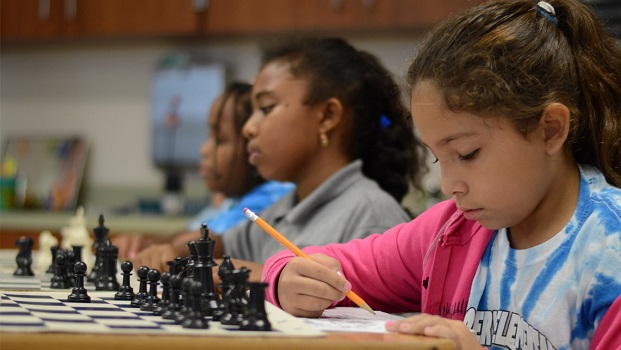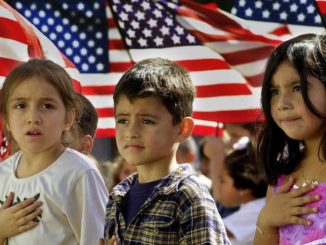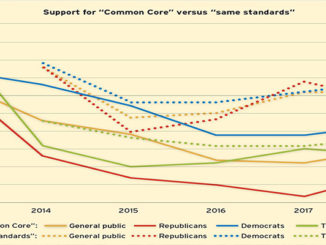
In a Chicago school this past April, one kindergartener fretted to a friend that he wouldn’t be able to get to his spare underpants if he had an accident. Why? Staff at the prestigious, private Catherine Cook School had opted to deny five- and six-year-olds access to their cubbies in order to school them on discrimination.
If one student did this to another, we would rightly call it bullying. But what do we call it when educators do it? If there were a Hippocratic Oath for kindergarten teachers, it would doubtless stipulate that educators not frighten or browbeat children in service of ideological agendas.
Although no scholars or federal agencies track such practices, we hear enough similar complaints from parents to suggest that they are far too common.
At the Catherine Cook School, kindergarten teachers each week send updates to their “Happy Puppy Families” to keep parents abreast of the goings-on in their child’s classroom. (“Happy Puppies” is the school’s nickname for the students.) Amid the standard fare requesting notifications about upcoming birthdays and praising the children’s work with puzzles and pinwheels, one April update announced a new “Equality Unit.” Five- and six-year-old students would be “examining the definitions [of] equality and fairness” and exploring these concepts by wrestling with such moral dilemmas as a situation in which one child is given more cookies than her friends.
So far, so good.
The following week, the bulletin informed parents that their children were being “introduced to the concepts of prejudice and discrimination . . . [and taught] that people can have unfair thoughts about entire groups.” To help students “fully comprehend prejudice and discrimination,” the April 21 update explained, students would be subjected to several “shared experiences” in the next few weeks. First, in the aforementioned “Great Locker Lock-Out,” the kindergarteners would arrive at school “to find their [cubbies] taped off” and closed to them. Afterward, students would participate in “repeated discussions” to reflect on how the lock-out “connects to the many ways in which groups of people have felt/currently feel discriminated against.”
After several days, parents received a cheerful email from the school noting that the kindergarteners had “decided to protest” the lock-out and inviting parents to attend the next morning’s “sit-in.” After the protest, one child’s parent recounted that her daughter had returned from school bewildered and concerned about several students who had cried during the “protest.”
The next week, in a bulletin that began by acknowledging that students were only starting to grasp the days of the week, parents were told that the “Happy Puppies” would build a historical timeline in order to “gain a better grasp of the historical contexts that have surrounded equity issues.” The teachers explained: “For our purposes, it is critical that children begin to organize major historical events, such as the Civil Rights Movement or the women’s suffrage movement in a sequential way.” This would allow these sprites to “make meaningful connections about the history of our country.”
A final “shared experience” would be segregation: Playground access during recess would be restricted; some students would enjoy full access to all of the usual equipment; others would be restricted to one corner of the playground that had none. The update promised: “We will discuss what this might feel like and connect it to how others might have felt when experiencing segregation in other circumstances. We expect children to feel uncomfortable and possibly angry or sad, depending on where they are playing that day.” The exercise was at least partly successful — in that some kindergarteners were indeed shaken and confused. One girl told her mother that the activity had so scared her that she didn’t want to go back to school.
When some parents raised questions about all of this, they were initially humored. Faculty patience quickly ran dry, however. In response to one parent’s query about the cubbie lock-out, the school’s early-childhood-division head replied, “It sounds like we need to clarify the activity and the goals of this lesson.” When the “clarifications” addressed none of the concerns, the parent followed up, endorsing “anti-bias” efforts and open discussion of such issues as fairness and privilege. The parent expressed concerns, however, about the age-appropriateness of the lessons. In response, the early-childhood-division head brusquely brought an end to the exchange after acidly explaining, “We don’t teach children that they’re privileged — they come to us privileged.”
Another family expressed concern that these lessons were taking time away from the core-subject curriculum and reported that they’d felt compelled to hire their child a math and reading tutor because she wasn’t getting the requisite exposure in school. In response, the principal told them, “Catherine Cook is a current-century, progressive school by it’s [sic] mission, by it’s [sic] design, and by it’s [sic] curriculum,” literacy, numeracy, and grammar apparently being last-century trifles.
Educators who regard themselves as socially conscious can get so invested in a political agenda that such issues as age-appropriateness seem hardly worth the worry. Such educators find it hard to believe that foisting their passions onto their students might not be in the students’ best interest.
Research justifying the kind of instruction taking place at Catherine Cook is wafer-thin. The bulk of relevant scholarship is far removed from the classroom, focusing on attempts to measure individuals’ level of racial prejudice or bias and ways to reduce or eliminate observed bias in laboratory or controlled training environments. One of the foundational works in this field, cited in thousands of peer-reviewed papers, is the Harvard University–hosted “Implicit Association Test” (IAT). The IAT has been the most influential measure in the study of unconscious or “implicit” bias since its creation in 1998, but, as the Chronicle of Higher Education reported earlier this year, scholars from the University of Wisconsin–Madison, the University of Virginia, and Harvard — including one of the three co-founders of the IAT — have found fundamental problems with the test. Examining 499 studies conducted over 20 years, involving 80,859 participants, the scholars discovered that not only does “the correlation between implicit bias and discriminatory behavior appear[] weaker than previously thought,” but there is also “very little evidence that changes in implicit bias have anything to do with changes in a person’s behavior.” As one of the researchers told the Chronicle, these findings “should be stunning”: They “produce a challenge” for the whole area of research, as “there’s not necessarily strong evidence for the conclusions people have drawn.”
As for the actual effect of “prejudice-reducing” programs such as those attempted at Catherine Cook, the simple fact is that most have never been experimentally evaluated. As a seminal 2009 study in the Annual Review of Psychology noted, “Although antibias, multicultural, and moral education are popular approaches, they have not been examined with a great deal of rigor, and many applications are theoretically ungrounded.”
Some of what we do know about promoting racial tolerance raises disconcerting questions about what transpired at Catherine Cook. One review of more than 500 studies on racial and ethnic interactions found, for instance, that the benefits from those interactions are conditional on the presence of positive forces, such as common goals, a sense of cooperation, and equal status, and vanish when individuals become anxious or nervous about cross-group interactions. The result? Efforts to combat bias, ineptly handled, can actually magnify racial tensions and conflict. In the hands of kindergarten teachers asked to haphazardly tackle sensitive instruction in between explaining shapes and reading stories, well-intended lessons might do more harm than good.
Asked for evidence that justified this kind of instruction, Catherine Cook faculty pointed parents to resources from Teaching Tolerance, a leading provider of free “anti-bias” curricula. Teaching Tolerance is a project of the Southern Poverty Law Center, an influential, left-leaning advocacy organization. Teaching Tolerance’s resources for pre-K and kindergarten include such titles as “Introducing Kids to the Idea of Environmental Racism” (“designed to simulate the inequity of environmental racism”) and “Think Outside the Box: Brainstorming About Gender Stereotypes” (“the first lesson in a series on gender expression”).
Notably, even the activists at Teaching Tolerance are more attentive to age-appropriate curricula than the teachers at Catherine Cook. For instance, Teaching Tolerance’s “The Sneetches” lesson activity appears to have been the model for the playground segregation exercise. The lesson promises, just as Catherine Cook’s teachers did, that “students will experience discrimination” after learning the concepts of “fairness and equity.” Yet even Teaching Tolerance doesn’t recommend the activity for kindergarteners and takes care to anchor the in-class activity in Dr. Seuss’s The Sneetches rather than Jim Crow.
Teaching Tolerance’s “Contemporary Movements” lesson also appears to have been used by Catherine Cook’s staff. In teaching the civil-rights movement, it involves having students “devise a timeline regarding other civil rights struggles . . . [that] will help them make connections and understand the complexity of interrelationships.” Teaching Tolerance recommends this lesson for students in grades six through twelve — not for kindergarteners.
The most striking thing about Catherine Cook’s instruction is how divorced it is from any obvious consideration of what’s healthy and appropriate for kindergarteners. The Illinois state standards for kindergarteners, for instance, set age-appropriate goals for interpersonal development. These goals encompass the most basic of social skills, such as “describ[ing] positive qualities in others” and “identify[ing] ways to work and play well with others.” It’s quite a leap to imagine that the same tykes are equipped to fruitfully experience and process discrimination.
At a time when battalions of advocates are urging schools to join an “anti-racist Resistance,” it’s easy for passion to override good judgment. It’s easy for some educators determined to share their convictions to gloss over students’ developmental needs or the importance of exposing students to a plurality of views.
Many parents, and many teachers, can be hesitant to speak up against these unwise education methods. They’re inclined to defer to the experts. They don’t want to come across as retrograde or cause a fuss or anger their children’s teachers. But the result is schools in which an impassioned minority can exercise undue influence in ways that don’t serve students and might aggravate the very ills they hope to cure.
The debate is not over whether students should be taught about empathy and privilege. They should. And kindergarteners should start learning about ideals such as equality, fairness, and personal responsibility. But it’s difficult to believe that kindergarteners benefit from play-acting violations of principles they as yet scarcely understand.
Teaching the next generation our common values is a goal that every American can embrace. We also should be able to agree that some things are out of bounds. What happened at Catherine Cook should give parents and educators pause and offer a chance to discuss how we can more constructively introduce our youngest students to our shared values.
Frederick Hess Resident Scholar and Director of Education Policy Studies at the American Enterprise Institute



